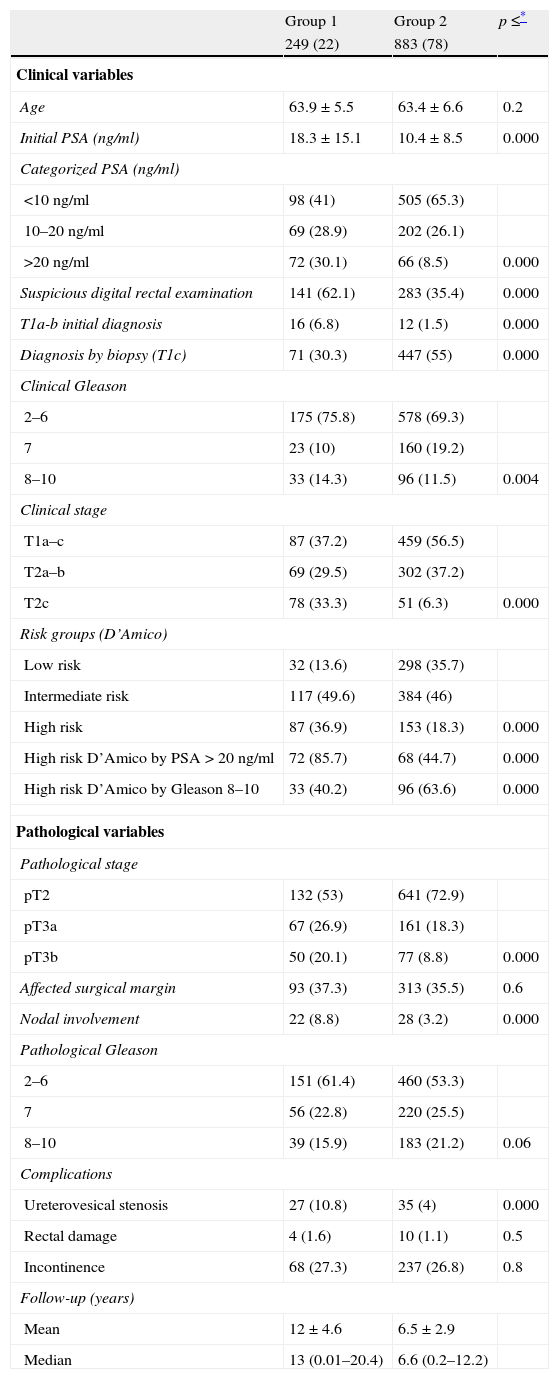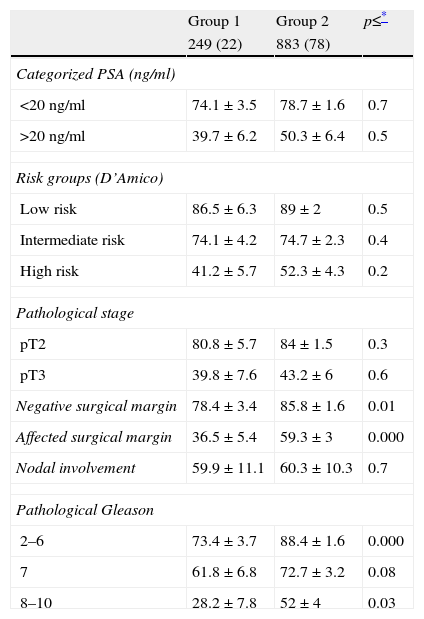To know the changes that there has experienced the profile of patient candidate to prostatectomía radically throughout last 2 decades in our institution.
Material and methodsWe analyze retrospectively a series of 1132 patients with prostate cancer stage T1–T2, submitted to radical prostatectomy during the period 1989–2009. The series is divided into five homogeneous groups as per the number of patients and arranged chronologically. The free survival of biochemical progression (SLPB) is used as a criterion for principal forecast.
ResultsIn spite of the changes in the diagnosis and treatment of the disease, from the point of view of the forecast (SLPB) we estimate two groups different from patients: the first 250 controlled ones and the rest. The point of chronological cut is placed in this series at 1999. We find significant differences in the majority of the clinical – pathological variables as PSA's level to the diagnosis (p<0.001), percentage of palpable tumors (p<0.001), clinical stage (p<0.001), Gleason in the prostate biopsy (p=0.004), groups at risk of D’Amico (p<0.001), pathological stage (p<0.001) and percentage of patients mincingly ganglionar (p<0.001). Nevertheless, there are some undetected differences of statistical significance in the Gleason of the specimen of prostatectomy (p=0.06) and in the percentage of surgical margins (p=0.6).
ConclusionsThis study analyzes a patient-wide proceeding sample from the whole Spanish geography and presents some important information that reflects the evolution that has suffered the cancer of prostate located, so much regarding the diagnosis as to the forecast, in our country in the last 20 years.
Conocer los cambios que ha experimentado el perfil de paciente candidato a prostatectomía radical a lo largo de las últimas 2 décadas en nuestra institución.
Material y métodosAnalizamos retrospectivamente una serie de 1.132 pacientes con cáncer de próstata estadio T1-T2, sometidos a prostatectomía radical durante el periodo 1989-2009. La serie se divide en 5 grupos homogéneos en cuanto al número de pacientes y ordenados cronológicamente. Se emplea la supervivencia libre de progresión bioquímica (SLPB) como criterio pronóstico principal.
ResultadosA pesar de los cambios en el diagnóstico y tratamiento de la enfermedad, desde el punto de vista del pronóstico (SLPB) apreciamos 2 grupos diferentes de pacientes: los primeros 250 intervenidos y el resto. El punto de corte cronológico se sitúa en esta serie en 1999. Encontramos diferencias significativas en la mayoría de las variables clínico-patológicas como nivel de PSA al diagnóstico (p < 0,001), porcentaje de tumores palpables (p < 0,001), estadio clínico (p < 0,001), Gleason en la biopsia prostática (p = 0,004), grupos de riesgo de D’Amico (p < 0,001), estadio patológico (p < 0,001) y porcentaje de pacientes con afectación ganglionar (p < 0,001). No obstante, no se detectan diferencias de significación estadística en el Gleason del espécimen de prostatectomía (p = 0,06) y en el porcentaje de márgenes quirúrgicos (p = 0,6).
ConclusionesEste estudio analiza una muestra amplia de pacientes procedente de toda la geografía española y presenta algunos datos importantes que reflejan la evolución que ha sufrido el cáncer de próstata localizado, tanto en lo que respecta al diagnóstico como al pronóstico, en nuestro país en los últimos 20 años.










